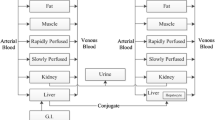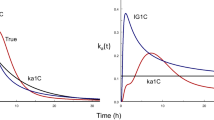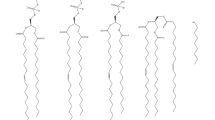Abstract
The objectives of this investigation were to characterize the disposition of fentanyl and alfentanil in 14 tissues in the rat, and to create physiological pharmacokinetic models for these opioids that would be scalable to man. We first created a parametric submodel for the disposition of either drug in each tissue and then assembled these submodels into whole-body models. The disposition of fentanyl and alfentanil in the heart and brain and of fentanyl in the lungs could be described by perfusion-limited 1-compartment models. The disposition of both opioids in all other examined tissues was characterized by 2- or 3-compartment models. From these models, the extraction ratios of the opioids in the various tissues could be calculated, confirming the generally lower extraction of alfentanil as compared to fentanyl. Assembly of the single-tissue models resulted in a whole-body model for fentanyl that accurately described its disposition in the rat. A similar assembly of the tissue models for alfentanil revealed non-first-order elimination kinetics that were not apparent in the blood concentration data. Michaelis-Menten parameters for the hepatic metabolism of alfentanil were determined by iterative optimization of the entire model. The parametric models were finally scaled to describe the disposition of fentanyl and alfentanil in humans.
Similar content being viewed by others
References
J. L. Gabrielsson, P. Johansson, U. Bondesson, and L. K. Paalzow. Analysis of methadone disposition in the pregnant rat by means of a physiological flow model.J. Pharmacokin. Biopharm. 13:355–372 (1985).
J. L. Gabrielsson and T. Groth. An extended physiological pharmacokinetic model of methadone disposition in the rat: validation and sensitivity analysis.J. Pharmacokin. Biopharm. 16:183–201 (1988).
J. L. Gabrielsson, P. Johansson, U. Bondesson, M. Karlsson, and L. K. Paalzow. Analysis of pethidine disposition in the pregnant rat by means of a physiological flow model.J. Pharmacokin. Biopharm. 14:381–395 (1986).
S. Björkman, D. R. Stanski, D. Verotta, and H. Harashima. Comparative tissue concentration profiles of fentanyl and alfentanil in humans predicted from tissue/blood partition data obtained in rats.Anesthesiology 72:865–873 (1990).
N. R. Davis and W. W. Mapleson. A physiological model for the distribution of injected agents, with special reference to pethidine.Br. J. Anaesth. 70:248–258 (1993).
K. B. Bischoff. Some fundamental considerations of the applications of pharmacokinetics to cancer chemotherapy.Cancer Chemother. Rep. 59:777–793 (1975).
R. J. Lutz, R. L. Dedrick, and D. S. Zaharko. Physiological pharmacokinetics: anin vivo approach to membrane transport.Pharmacol. Ther. 11:559–592 (1980).
L. E. Gerlowski and R. K. Jain. Physiologically based pharmacokinetic modeling: principles and applications.J. Pharm. Sci. 72:1103–1127 (1983).
S. Björkman, D. R. Stanski, H. Harashima, R. Dowrie, S. R. Harapat, D. R. Wada, and W. F. Ebling. Tissue distribution of fentanyl and alfentanil in the rat cannot be described by a blood flow limited model.J. Pharmacokin. Biopharm. 21:255–279 (1993).
F. G. King and R. L. Dedrick. Physiologic model for the pharmacokinetics of 2′-deoxycoformycin in normal and leukemic mice.J. Pharmacokin. Biopharm. 9:519–534 (1981).
M. J. Angelo, K. B. Bischoff, A. B. Pritchard, and M. A. Presser. A physiological model for the pharmacokinetics of methylene chloride in B6C3F1 mice following intravenous administrations.J. Pharmacokin. Biopharm. 12:413–436 (1984).
J. M. Gallo, P. Varkonyi, E. E. Hassan, and D. R. Groothius. Targeting anticancer drugs to the brain: II. Physiological pharmacokinetic model of oxantrazole following intraarterial administration to rat glioma-2 (RG-2) bearing rats.J. Pharmacokin. Biopharm. 21:575–592 (1993).
W. F. Ebling, D. R. Wada, and D. R. Stanski. From piecewise to full physiologic pharmacokinetic modeling: applied to thiopental disposition in the rat.J. Pharmacokin. Biopharm. 22:259–292 (1994).
S. Björkman and D. R. Stanski. Simultaneous determination of fentanyl and alfentanil in rat tissues by capillary column gas chromatography.J. Chromatog. 433:95–104 (1988).
D. Z. D'Argenio and A. Schumitzky. A program package for simulation and parameter estimation in pharmacokinetic systems.Comput. Prog. Biomed. 9:115–134 (1979).
L. R. Williams and R. W. Leggett. Reference values for resting blood flow to organs of man.Clin. Phys. Physiol. Meas. 10:187–217 (1989).
N. B. Everett, B. Simmons, and E. P. Lasher. Distribution of blood (Fe59) and plasma (I131) volumes of rats determined by liquid nitrogen freezing.Circ. Res. 4:419–424 (1956).
D. R. Wada, D. R. Stanski, and W. F. Ebling. A PC-based graphical simulator for physiological pharmacokinetic models.Comput. Meth Prog. Biomed. (in press).
K. Yamaoka, T. Nakagawa, and T. Uno. Application of Akaike's information criterion (AIC) in the evaluation of linear pharmacokinetic equations.J. Pharmacokin. Biopharm. 6:165–175 (1978).
K. Taeger, E. Weninger, F. Schmelzer, M. Adt, N. Franke, and K. Peter. Pulmonary kinetics of fentanyl and alfentanil in surgical patients.Br. J. Anaesth. 61:425–434 (1988).
F. Boer, J. G. Bovill, A. G. L. Burm, and R. A. G. Mooren. Uptake of sufentanil, alfentanil and morphine in the lungs of patients about to undergo coronary artery surgery.Br. J. Anaesth. 68:370–375 (1992).
J. R. Varvel, S. L. Shafer, S. S. Hwang, P. A. Coen, and D. R. Stanski. Absorption characteristics of transdermally administered fentanyl.Anesthesiology 70:928–934 (1989).
H. J. M. Lemmens, J. B. Dyck, S. L. Shafer, and D. R. Stanski. Pharmacokinetic/dynamic modeling in drug development: Application to the investigational opioid trefentanil.Clin. Pharmacol. Ther. 56:261–271 (1994).
W. E. G. Meuldermans, R. M. A. Hurkmans, and J. J. P. Heykants. Plasma protein binding and distribution of fentanyl, sufentanil, alfentanil and lofentanil in blood.Arch. int. Pharmacodyn. 257:4–19 (1982).
M. Yaster, R. C. Koehler, and R. J. Traystman, Effects of fentanyl on peripheral and cerebral hemodynamics in neonatal lambs.Anesthesiology 66:524–530 (1987).
N. D. Kien, J. A. Reitan, D. A. White, C-H. Wu, and J. H. Eisele. Hemodynamic responses to alfentanil in halothane-anesthetized dogs.Anesth. Analg. 65:765–770 (1986).
S. S. Kety. The theory and applications of the exchange of inert gas at the lungs and tissues.Pharmacol. Rev. 3:1–40 (1951).
S. Björkman, J. Åkeson, F. Nilsson, K. Messeter, and B. Roth. Ketamine and midazolam decrease cerebral blood flow and consequently their own rate of transport to the brain: An application of mass balance pharmacokinetics with a changing regional blood flow.J. Pharmacokin. Biopharm. 20:637–652 (1992).
J. D. Horowitz, M. K. Dynon, E. Woodward, S. T. B. Sia, P. S. MacDonald, D. J. Morgan, A. J. Globe, and W. J. Louis. Short-term myocardial uptake of lidocaine and mexiletine in patients with ischemic heart disease.Circulation 73:987–996 (1986).
Y. F. Huang, R. N. Upton, and W. B. Runciman. I.V. bolus administration of subconvulsive doses of lignocaine to conscious sheep: Myocardial pharmacokinetics.Br. J. Anaesth. 70:326–332 (1993).
G. P. Stec and A. J. Atkinson. Analysis of the contributions of permeability and flow to intercompartmental clearance.J. Pharmacokin. Biopharm. 9:167–180 (1981).
D. L. Roerig, K. J. Kotrly, E. J. Vucins, S. B. Ahlf, C. A. Dawson, and J. P. Kampine. First pass uptake of fentanyl, meperidine, and morphine in the human lung.Anesthesiology 67:466–472 (1987)
D. L. Roerig, K. J. Kotrly, S. B. Ahlf, C. A.Dawson, and J. P. Kampine. Effect of propranolol on the first pass uptake of fentanyl in the human and rat lung.Anesthesiology 71:62–68 (1989).
R. Hess, A. Herz, and K. Friedel. Pharmacokinetics of fentanyl in rabbits in view of the importance for limiting the effect.J. Pharmacol. Exp. Ther. 179:474–484 (1971).
C. C. Hug and M. R. Murphy. Tissue redistribution of fentanyl and termination of its effects in rats.Anesthesiology,55:369–375 (1981).
K. A. Lehmann, L. Hunger, K. Brandt, and D. Daub. Biotransformation von Fentanyl.Anaesthetist 32:165–173 (1983).
E. Schneider and K. Brune. Distribution of fentanyl in rats: an autoradiographic study.Naunyn-Schmiedebergs Arch. Pharmacol. 331:359–363 (1985).
H. Stoeckel, J. H. Hengstmann, and J. Schüttler. Pharmacokinetics of fentanyl as a possible explanation for recurrence of respiratory depression.Br. J. Anaesth. 51:741–745 (1979).
L. B. Sheiner. Analysis of pharmacokinetic data using parametric models. II. Point estimates of an individual's parameters.J. Pharmacokin. Biopharm. 13:515–540 (1985).
Author information
Authors and Affiliations
Additional information
Supported in part by the National Institute on Aging, RO1-AG-4594, and the Anesthesia/Pharmacology Research Foundation.
An erratum to this article is available at http://dx.doi.org/10.1007/BF02353643.
Rights and permissions
About this article
Cite this article
Björkman, S., Wada, D.R., Stanski, D.R. et al. Comparative physiological pharmacokinetics of fentanyl and alfentanil in rats and humans based on parametric single-tissue models. Journal of Pharmacokinetics and Biopharmaceutics 22, 381–410 (1994). https://doi.org/10.1007/BF02353862
Received:
Accepted:
Published:
Issue Date:
DOI: https://doi.org/10.1007/BF02353862




